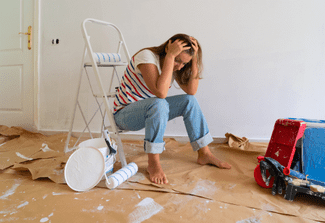There is no clear line defining the difference between a rehab and a fixer upper. Generally, a fixer only needs some relatively inexpensive cosmetic improvements to increase the property value. Often a fixer involves repairing a few dinged walls, fresh paint, new carpet, or refinished floors. You start entering a grey area by replacing major appliances in the kitchen. It becomes a full rehab when water damage must be repaired, a new roof is needed, and/or kitchen appliances are relocated.
You can usually live in the home while doing fixer projects, but a rehab is often uninhabitable or difficult to live in for a period of time. Of course, the costs are also significantly different. Painting the entire interior of a typical house and replacing carpet can cost $15,000 or less. You can also fix up one room at a time to spread the cost out over time. According to HomeAdvisor, a typical rehab will cost anywhere from $18,000 to $79,000 or more. A rehab house can be uninhabitable as walls are ripped out and kitchens or bathrooms are completely demolished to begin again.
Pros and Cons of Buying Rehab
 On the other hand, turnkey homes are ready to move in and these are what the vast number of homebuyers are looking for. They are also looking for the convenience of moving in over the weekend, putting the dishes in the cupboards, and going to work on Monday with minimal disruption to their lives. Compared to a rehab, homebuyers pay dearly for the convenience of a turnkey. That is why there is a strong market of investors that do the rehab in return for a substantial profit selling turnkey ready homes.
On the other hand, turnkey homes are ready to move in and these are what the vast number of homebuyers are looking for. They are also looking for the convenience of moving in over the weekend, putting the dishes in the cupboards, and going to work on Monday with minimal disruption to their lives. Compared to a rehab, homebuyers pay dearly for the convenience of a turnkey. That is why there is a strong market of investors that do the rehab in return for a substantial profit selling turnkey ready homes.
But you don’t have to be an investor to take on a rehab and turn it into your dream home. In fact, the FHA offers loans specifically targeting homebuyers that want to rehab a home to live in.
The biggest pro for buying a rehab is the cost. It’s not just the purchase price that will be lower, but a rehab also requires a smaller down payment to get started. Of course, this also brings the con of needing money to do the renovation. If you’re having trouble with the down payment, chances are that you will not have the money for the renovation anytime soon. That is something that makes the FHA 203k loan appealing because it includes the rehab money.
Another big pro is that there is less competition for rehab homes because most buyers are looking for turnkey. This improves your chances of finding an older house with good bones at a decent price that you can renovate into what you want. The con here is that the competition that you do face probably includes rehab investors that have more experience than you. Be careful before outbidding a professional rehabber that knows more about the costs and future value than you do.
Customizing your own home is one of the biggest pros of a rehab. Want a deck off the master bedroom? Build one. Want a walk-in shower? Build it. You have the freedom to do whatever you want. Once you do the cost analysis on the purchase and rehab costs, customizing the home the way you want becomes the biggest pro and it doesn’t really have any downside. Customization is such a benefit that many people choose to rehab the homes that they already live in rather than buying a more modern home. Quality control also falls within the scope of customization. You get to decide room sizes, materials, colors, contractors, and everything else.
However, there are a few other potential cons. It’s not unusual to spend more than you planned on a renovation. It could be because you discover an unexpected problem that needs repairing, or the cost of materials/labor goes up, or you change your mind about exactly what you want. It’s always good to budget at least 20% more than your estimate. Another possible con happens when the work takes longer than you plan for. You may become very disgruntled living in a construction zone or have the added cost of living somewhere else for longer than expected.
What to Consider Before Buying a Rehab
Do an honest assessment of what you want before looking at houses. You want to be sure the house you are looking at can be rehabbed into the house that you dream of. You should also evaluate the skills that you have and the amount of time you’ll be able to apply to the work. You’ll probably gain some skills as you go along but you’re not likely to go from being able to replace a light switch to changing out the main electrical panel with the help of professional electricians from Roswell, GA. Know what you can reasonably do yourself and what you’ll need to hire professionals for.
Before you make an offer, you should have your financing in place that includes the rehab costs. Having a backup plan for financing is always a good idea. You also want to assemble a team of contractors if you’ll be having work done by professionals. Time is money and you want to minimize the time that construction will be going on. On the day of closing, you want to be able to start your Fast Paced Rehabbing.
No comments:
Post a Comment